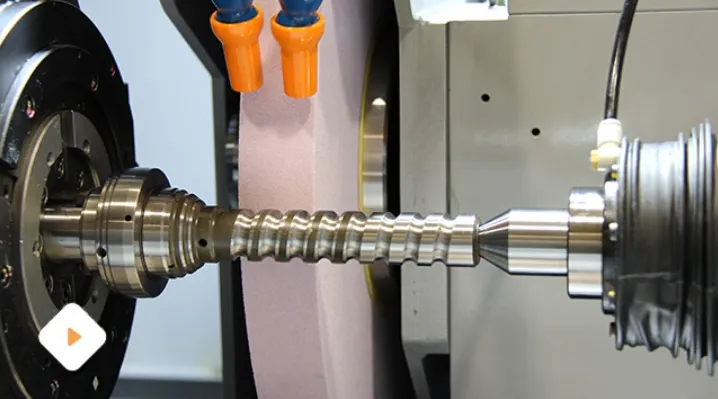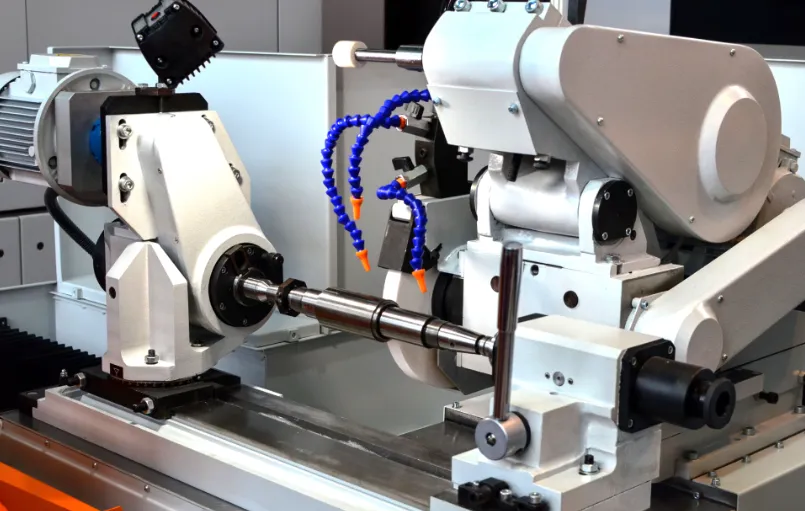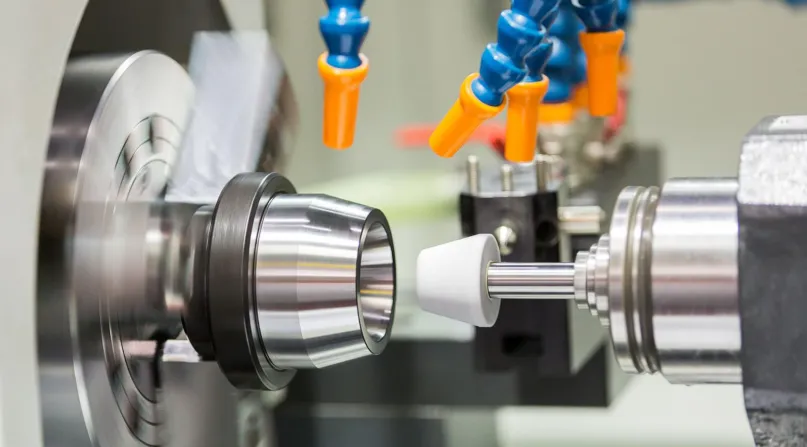Machine Architecture and Structural Design
Modern CNC grinding machines feature reinforced cast iron or polymer concrete bases that provide exceptional vibration damping and thermal stability. The machine frame incorporates precision-ground ways or linear guide rails that maintain geometric accuracy under heavy cutting loads. A typical horizontal spindle grinding machine stands on a massive granite surface plate, ensuring flatness within 2 microns per meter. The moving components – including the wheelhead, workhead, and tailstock – mount on hydrostatic or linear roller bearings that eliminate stick-slip motion during fine finishing operations. Larger machines may weigh over 20 tons, with the massive structure necessary to achieve the sub-micron accuracy required for precision grinding applications.
 Axis Configurations and Motion Control
Axis Configurations and Motion Control
CNC grinding systems employ various axis configurations depending on their specialized applications. Basic cylindrical grinders utilize X (radial), Z (longitudinal), and sometimes C (workpiece rotation) axes, while complex universal grinders incorporate up to 7 controlled axes for intricate geometries. Linear motors or precision ball screws driven by AC servo motors provide axis movement, with resolutions reaching 0.1 micron on high-end machines. Rotary axes often use direct-drive torque motors that eliminate backlash while providing positioning accuracy within 2 arc seconds. The machine control continuously monitors and compensates for thermal expansion of critical components through embedded temperature sensors along each axis.
Grinding Wheel Technology and Spindle Systems
The heart of any grinding machine lies in its wheel spindle assembly. High-frequency motorized spindles (up to 60,000 RPM) mount precision-balanced grinding wheels with runout less than 1 micron. Wheel adapters use hydrostatic expansion systems that ensure perfect concentricity during mounting. Modern abrasive wheels combine superabrasive materials (CBN or diamond) with advanced bond systems (vitrified, metal, or hybrid bonds) optimized for specific materials. Wheel dressing systems employ rotary diamond dressers or laser dressing technology to maintain optimal wheel geometry and sharpness. Automatic wheel changers allow for multiple grinding operations in a single setup, with some machines handling over 20 different wheels.

Workpiece Holding and Fixturing
Precision grinding demands exceptional workpiece stability, achieved through various fixturing methods. Magnetic chucks with variable pole patterns secure ferrous materials while minimizing distortion. Special vacuum chucks handle non-magnetic materials like ceramics or carbides. Between-centers grinding uses precision live centers with runout under 1 micron. For complex parts, customized fixtures with hydraulic expansion mandrels or mechanical clamping systems provide the necessary support. The workhead spindle often incorporates high-resolution encoders for precise angular positioning during form grinding operations.
Control Systems and Software
Advanced CNC grinding machines run on proprietary control platforms with specialized grinding software. The human-machine interface typically features large touchscreen displays showing real-time process monitoring data. Sophisticated algorithms control:
- Adaptive feed rates based on spindle load monitoring
- Thermal compensation calculations
- Wheel wear compensation
- Process optimization for cycle time reduction
The systems store hundreds of grinding cycles with parameters for different materials and wheel combinations. Many controls now incorporate artificial intelligence that learns from previous operations to optimize future cycles.

Coolant and Lubrication Systems
High-performance grinding requires precise coolant delivery to manage heat generation and remove swarf. Multi-nozzle systems deliver filtered coolant at pressures up to 30 bar directly to the grinding zone. Centrifugal filtration systems maintain coolant cleanliness below 5 microns particle size. Some machines employ cryogenic cooling with liquid nitrogen for difficult-to-grind materials. The lubrication systems for machine ways and spindles use temperature-controlled oil circulation with filtration down to 3 microns.
Measurement and In-Process Gauging
Modern grinding machines incorporate various measurement systems:
- Touch probe systems for workpiece setup and inspection
- Laser measurement devices for wheel profiling
- In-process gauging systems that measure parts during grinding
- Post-process measuring devices that verify final dimensions
These systems feed data back to the CNC control for automatic compensation of wheel wear and thermal effects. Air gauging systems provide non-contact measurement of internal diameters with 0.1 micron resolution.

Applications and Material Considerations
CNC grinding machines process an extensive range of materials:
- Tool steels and hardened alloys (HRC 45-65)
- Carbides and ceramics
- Superalloys (Inconel, Hastelloy)
- Glass and optical materials
- Composites and polymers
Each material requires specific wheel compositions, speeds, and coolant formulations. The machines produce parts with surface finishes down to Ra 0.025 microns and dimensional tolerances within ±0.5 microns for precision applications.
Automation and Integration
Automated grinding cells incorporate:
- Robotic loading/unloading systems
- Automated wheel changing
- Integrated measuring stations
- Conveyor systems for part handling
- Centralized swarf management
These systems enable lights-out operation with minimal human intervention. Some advanced setups connect to factory-wide monitoring systems that track tool life, machine utilization, and quality metrics.

Safety Systems and Maintenance
Comprehensive safety features include:
- Enclosure interlocks that prevent operation when doors are open
- Wheel burst containment systems
- Coolant mist extraction
- Emergency stop circuits with redundant monitoring
- Vibration monitoring for wheel imbalance detection
Preventive maintenance programs track spindle hours, way lubrication, and filter conditions to prevent unscheduled downtime. Many machines now feature condition monitoring systems that predict component failures before they occur.
Emerging Technologies
The grinding industry continues advancing with:
- Laser-assisted grinding that reduces cutting forces
- Ultrasonic vibration-assisted processes
- Hybrid additive/subtractive grinding systems
- AI-powered process optimization
- Digital twin simulations for process development
These innovations push the boundaries of what’s possible in precision grinding while improving efficiency and reducing environmental impact.
Industry-Specific Solutions
Different sectors require specialized grinding solutions:
- Automotive: Camshaft and crankshaft grinding
- Aerospace: Turbine blade root form grinding
- Medical: Implant and surgical instrument finishing
- Tooling: Cutting tool and insert production
- Optics: Lens and mirror surface generation
Each application demands unique machine configurations and process know-how to achieve the required results.
Economic Considerations
While CNC grinding machines represent significant capital investments (ranging from $150,000 to over $1 million), their precision capabilities often justify the cost through:
- Reduced scrap rates
- Lower secondary operations
- Extended tool life
- Improved part performance
- Higher production throughput
The total cost of ownership analysis must consider energy consumption, consumables (wheels, coolant), and maintenance requirements over the machine’s lifespan.
Training and Skill Requirements
Operating CNC grinding machines requires specialized knowledge in:
- Wheel selection and conditioning
- Process parameter optimization
- Machine programming
- Metrology and quality control
- Maintenance procedures
Many manufacturers offer comprehensive training programs to develop these competencies in operators and programmers.
Environmental Considerations
Modern grinding machines address environmental concerns through:
- Energy-efficient spindle drives
- Coolant recycling systems
- Swarf reclamation processes
- Noise reduction enclosures
- Minimal lubricant consumption designs
These features help manufacturers meet increasingly stringent environmental regulations while reducing operating costs.
Future Outlook
The grinding machine industry continues evolving toward:
- Greater connectivity and data analytics
- More sophisticated automation
- Improved energy efficiency
- Enhanced process monitoring
- Tighter integration with manufacturing systems
These developments will further cement CNC grinding’s position as an essential manufacturing process for high-precision components across industries.




